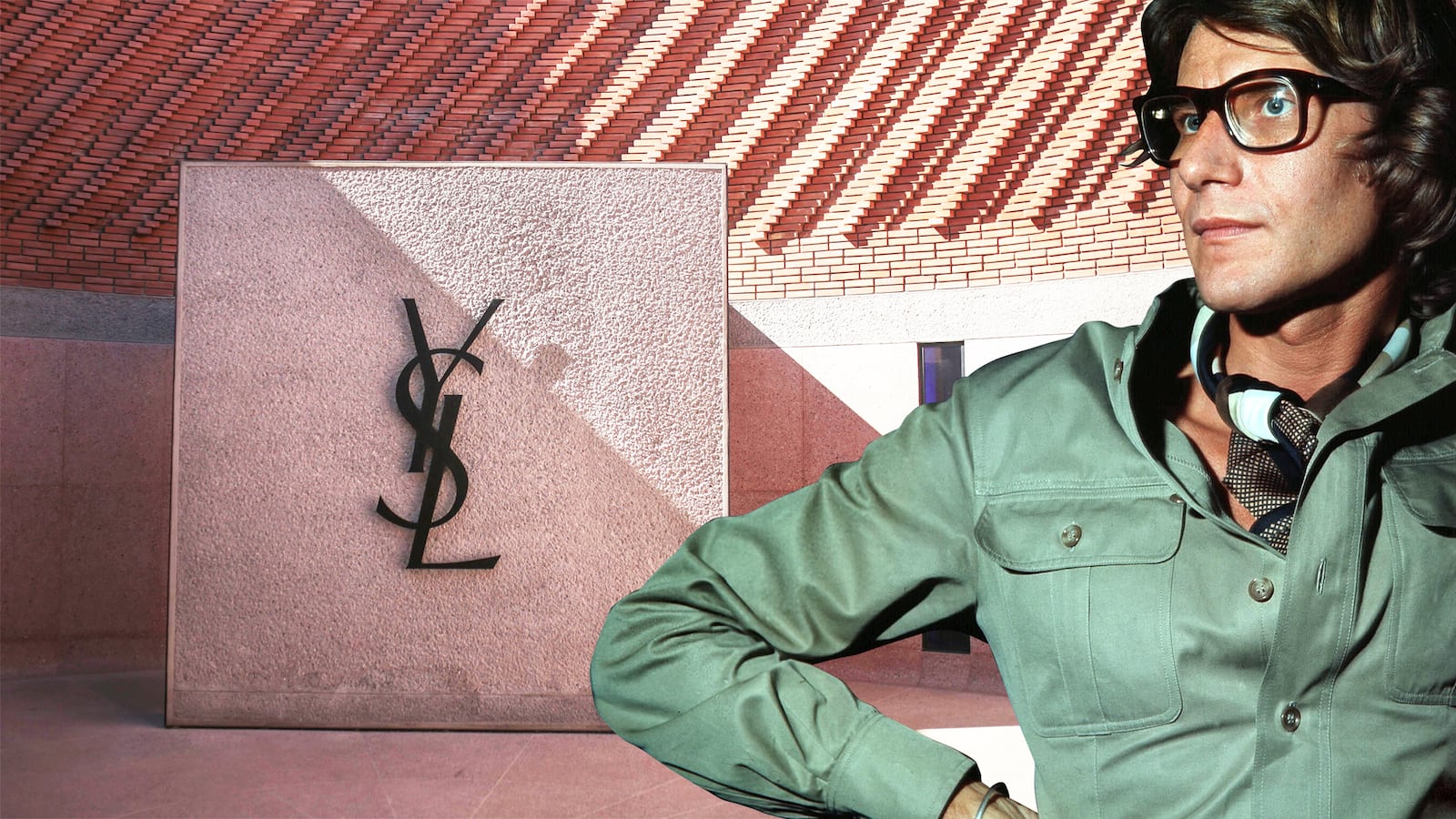MARRAKECH—The Jardin Majorelle, Pierre Bergé and Yves Saint Laurent’s Marrakech gardens, have long been a celebration of Berber culture–not to mention exotic plants.
But this legendary Marrakech site that was rescued by the late designer and his partner Pierre Bergé, who died last month aged 86, has also just become home to one of two new YSL Museums.
The state-of-the-art Musée Yves Saint Laurent Marrakech (mYSLm), complete with its eye-catching YSL logo inside, is opening its 4,000-square-meter interiors on Oct. 19, a month after the man behind it, Pierre Bergé, died.
Saint Laurent, who died in 2008, often designed his collections while in Marrakech, and the couple had a home here, Villa Oasis. Designed by French architects KO Studios, the museum will keep on display some of the Fondation Pierre Bergé, Yves Saint Laurent’s collection of 5,000 clothing items and 15,000 accessories.

The Majorelle Garden in the Moroccan city of Marrakesh.
FADEL SENNA/AFP/GettyAs finishing touches were being put to the museum this week, the vibrant colors of some of the dresses, displayed on dark platforms–with a projected image of the designer in a white suit looking down upon them–appeared to resemble some of the Berber outfits already on display at the Jardin’s existing Berber museum.
Other highlights from the legendary label’s clothing collection are already on show at Musée Yves Saint Laurent Paris, a second YSL Museum that opened in Paris earlier this month, in YSL’s former headquarters on Rue Marceau.
“Ten years after the passing of Yves Saint Laurent, I wanted the spaces of 5 Avenue Marceau to be exclusively dedicated to the presentation of his work,” Bergé told me in a rare interview conducted by email earlier this year. “By opening the doors of the former fashion house to the public, I wanted the Parisian audience and tourists to be able to experience the universe of our generation’s greatest fashion designer. This museum will be the first in the capital to exclusively display the work of one fashion designer.”
Even before some of the designer’s flamboyant dresses arrived in Marrakech, the Jardin Majorelle, where the new museum is situated, was already one of the most beautiful destinations in the city.

The gardens are more often than not packed with visitors enjoying the beautiful juxtaposition of the vivid Majorelle blue, used to paint the Berber Museum at the heart of the complex, with the vibrant green foliage in the fabled gardens that surround it. The new museum has been built from scratch next door. It looks decidedly modern.
(Majorelle Blue was created by the French artist Jacques Majorelle who originally owned the home and gardens. They had fallen into disrepair when Saint Laurent and Bergé bought the property. Majorelle’s former atelier is now the Berber museum.)
Until now, the glistening Berber jewels collected by the couple that are shown inside the Berber museum under a display of bright stars resembling those seen shining about the Sahara, and the bright green cacti—that rise like totem poles outdoors in the stunning gardens—have been the main attractions. But now there is so much more to see.
Consider a long, multi-colored harlequin style skirt, worn on a dark mannequin, with what look like ropes tied around the waist. Several floor-length YSL draped dresses in bright colors bring to mind the bright textiles still seen in traditional outfits on the streets of Marrakech. Then there is a more somber-looking display of elegant, darker evening pieces inside the new museum.
“More than a museum, our project in Marrakesh can be seen as a real cultural center,” Bergé wrote to me.
In addition to its permanent exhibition space, displaying the work of Yves Saint Laurent, “a temporary exhibitions space, a 130-seat auditorium, a book shop, a cafe restaurant, a library and research center with 5,000 books, are all part of this new building, spanning over 4,000 square meters,” Bergé wrote.
‘It was in Morocco he first felt the power and importance of color’
Bergé also donated rare books from his private collection to help create the library, including “thousands of volumes relating to Arabo-Andalusian culture, and the Berber people, botany and fashion,” says Madison Cox, the American landscape artist who married Mr. Bergé earlier this year, and is now the president of the Fondation.
Cox has long been responsible for the beautiful gardens, and previously served as the vice president of the Fondation Jardin Majorelle. He is the presumptive heir of the estate, and its executor. As The New York Times reported, Cox also has a partner of 11 years, Jaimal Odedra, a designer of Bollywood costumes and home accessories, This led, as the paper put it, to an “operatic emotional triangle with Mr. Saint Laurent.”

The mYSLm has been designed using the most state-of-the-art conservation technologies for both Yves Saint Laurent’s couture and the Berber artifacts that are displayed in the Berber Museum, says Cox.
“Specially trained Moroccan staff will employ the latest techniques for the, preventative conservation and restoration of textiles and other related objects. In its approach to conserving and promoting the arts, and in the programming for both the Moroccan and international visiting public, the mYSLm will be a dynamic and pioneering institution in Marrakech,” he says.
Bjoern Dhalstroem, the curator of the Berber Museum, is also now the curator of the complex in Marrakech. But why show YSL clothing here?
“The Jardin Majorelle and Marrakech are inseparably linked with Yves Saint Laurent, who made the city his second home, after arriving in 1966,” says Cox. “It makes perfect sense to offer visitors the opportunity to discover more about this couturier who owes so much to Morocco.
“Soon after buying their first house in the medina, Yves Saint Laurent began designing future collections while staying in Marrakech. The city inspired him profoundly. Saint Laurent said many times that it was in Morocco he first felt the power and importance of color. Perhaps it was the magical, late afternoon light, or the cascade of flowers he’d see in his garden, or the bold colors worn by the local women,” says Cox.
Several examples come to mind of how this influenced him. “The exquisite palette and color combinations so unique to his work, his 1967 African collection and his ‘Saharienne’ jacket of 1968 all testify to his passion for the African continent. And let’s not forget that Yves Saint Laurent was born in the neighboring North African country of Algeria, so Morocco truly became a second home for him,” adds Cox.
The Majorelle already has much to offer. 14,000 Berber artifacts collected by Pierre Bergé and Yves Saint Laurent stand in a dazzling display inside the Berber museum. Large angular fibulas, a staple of Berber jewelry, and chunky reefs of coral that look like vertebrae conjoined together, help make up one of the most significant selections of Berber jewelry.

A Berber guide showed off a collection of early mascara tubes and bottles, and tribal clothes and artifacts.
The museum’s collection has provided inspiration for the beautiful designs sold in the Majorelle’s shop.
Stephen Di Renza, the creative director of retail operations, has used the best materials and local craftsmen to create unique pieces, like embroidered purses and soft blankets. The shop also sells recreations of a jewelry collection from Saint Laurent’s muse and collaborator, Loulou de la Falaise.
Reached through a side gate, Villa Oasis, Majorelle’s renamed house, is a shrine to beautiful interior design. Since 2015, it has also been open for select visits. The property was built on land acquired by Majorelle in the 1920s. Yves Saint Laurent and Bergé saved the gardens and property in 1980. Saint Laurent’s ashes were scattered here in 2008. A Memorial stands to him in the public gardens.
“I am delighted that the work of Yves, who always claimed to have learned the use of colors in Morocco, will be on display on the country he loved so much,” wrote Bergé in the email interview.
Bergé added: “Differences (between Marrakesh and the Paris museum) are vast. The Marrakech auditorium will offer a significant music and film program, making it a real social space. In Paris, the museum’s specificity is to be housed in the historical fashion house. Both projects, beyond being located in Yves’ most cherished cities, are therefore perfectly complimentary.”
But why now? “The time has come to promote and display the work of the Fondation in a permanent, sustainable way, across the two museums,” said Bergé.






